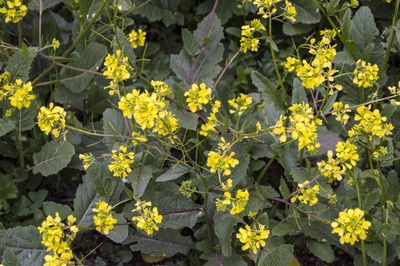About Wild Mustard Plants
Mustard, Sinapis arvensis, is in the same family as cabbage, broccoli, turnips, and others. All wild mustards are edible, but some are tastier than others. Greens are most succulent when young and tender. Older leaves may be a bit too strong for some palates. Seeds and flowers are also edible. Flowers bloom from spring through summer. The little yellow blossoms have a unique shape, like that of a Maltese cross, a nod to their family name of Cruciferae, or cross like. Wild mustard, also known as charlock, grows rapidly, is frost and drought tolerant, and can be found growing wild in fields and along roads in almost any type of soil. As mentioned, wild mustard plants grow prolifically, a fact that has irritated many a cattle rancher. Cattle growers tend to think of wild mustard as more of a plague since there is a general consensus that when cows eat the plant, they get very sick.
How to Use Wild Mustard
Wild mustard can be used as an herb to spice up oils and vinegars, to add flavor to ho-hum eggs or potatoes, and to enliven many other culinary creations. Of course, we can’t forget mustard’s use as a condiment, to me it’s THE condiment. Grind the seeds, mix with vinegar and salt and voila! Wild mustard greens are also delicious and can be cooked down to a nutritious mess of greens. Flowers from mustard can be tossed into salads for some peppery pizzazz or used dry in place of pricey saffron. The seeds from mustard can be dried and then ground into powder and used as a peppery spice. Used whole, the seeds give a kick to pickles and relishes. The seeds can also be pressed to separate their oils, which burn quite well and can be used in oil lamps or for cooking. Historically, though, wild mustard herbal use was geared more towards its medicinal properties. Ever heard of a mustard plaster? A mustard plaster was (and still is I suppose) crushed or ground mustard seed mixed with a bit of water to make a paste. The paste was then spread on a cloth and placed herb side up on a person’s chest, sore joints, or other areas of swelling and pain. Mustard opens up blood vessels and allows the blood system to draw out toxins and increase blood flow, reducing swelling and pain. Wild mustard can also help reduce headache pain when taken as a tea or encapsulated. Sinuses can be cleared by inhaling mustard vapor over a bowl filled with hot water combined with a small amount of ground mustard. The user drapes a towel over their head and inhales the spicy vapor. There is some risk associated with using mustard medicinally. Some people are quite sensitive to it, and it can cause stomach problems, eye irritation, or skin rashes.
Additional Uses for Wild Mustard
Mustard oil can be painted onto items you don’t want your dog to chew on or the cat to scratch. It is, in fact, the active ingredient in commercially prepared products of this nature. Mustard oil can also be used as a lubricant as it thickens but never fully dries out. The plant produces a pale semi-permanent dye, and the flowers also produce a semi-permanent yellow/green dye. Cultivating wild mustard as a green manure is arguably one of the best uses for the plant. A green manure is a plant that grows quickly and is then tilled back into the soil to enrich it and wild mustard fills this roll beautifully. Plus, while it’s growing, you can harvest a little for yourself to flavor food or for medicinal uses – a win/win.
